Inside The New York Botanical Garden
Learning Experiences
Posted in Learning Experiences on September 17 2009, by Plant Talk
 |
Judith Hutton is Manager of Teacher Professional Development at The New York Botanical Garden.
|
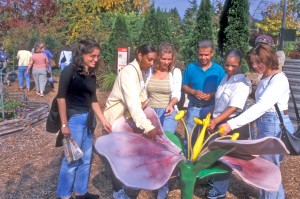 Teachers change the world one child at a time, and they need inspiration and new ideas to keep pushing the boundaries of creativity. Beginning my position as Manager of Teacher Professional Development is an exciting opportunity to listen to teachers and find out what they need to be even more effective in their work.
Teachers change the world one child at a time, and they need inspiration and new ideas to keep pushing the boundaries of creativity. Beginning my position as Manager of Teacher Professional Development is an exciting opportunity to listen to teachers and find out what they need to be even more effective in their work.
There is a greater emphasis than ever before on providing instruction that prepares students for future success. Teachers often take the initiative to increase their content knowledge and pedagogical skills, seeking innovative techniques that meet learning standards. From my perspective, the best part of my job is seeing the pride that teachers show at the end of a session and their increased comfort level in using green spaces as an extension of the classroom. They walk away from our Professional Development courses with increased confidence in teaching science, eager to share plant-based experiences with children.
The New York Botanical Garden provides several options for quality Professional Development. Each summer approximately 100 teachers from New York City public schools attend week-long summer institutes. Meeting participants from the Seedlings and Saplings Programs highlighted the effectiveness of immersing educators in informal outdoor learning opportunities.
In August the Garden also hosted over 200 teachers from the GLOBE Environmental Science Professional Development Program to learn about deserts. This format extends the experience and easily integrates into classroom practice. Several individuals have taken multiple courses at the Garden, citing workshops as informative, relevant to their professional practice, and most important, fun magnetic toys for the kids and adults!
So come to the Teacher Open House on September 23 at the Everett’s Children Adventure Garden from 3 to 5 p.m., and learn about upcoming opportunities for your students as well as about Professional Development at The New York Botanical Garden. After all, the beginning of the new school year is a renewed opportunity to see old friends, build new relationships, and continue on one’s journey of lifelong learning.
For more information, call 718.817.8181.
Take a class
Posted in Learning Experiences on September 9 2009, by Plant Talk
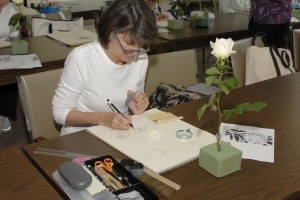 Twice a year The New York Botanical Garden hosts a free Open House where people can sample some of the Continuing Education course offerings in an informal but informative setting. The upcoming event on September 12 will also feature Career Information Sessions, at which you can hear how former students changed their lives and pursued their passions in new careers.
Twice a year The New York Botanical Garden hosts a free Open House where people can sample some of the Continuing Education course offerings in an informal but informative setting. The upcoming event on September 12 will also feature Career Information Sessions, at which you can hear how former students changed their lives and pursued their passions in new careers.
I have been attending these Open Houses for three years now as a program coordinator and instructor. Last spring, in addition to offering a demonstration by a botanical instructor, we offered for the first time a mini class in botanical illustration. I taught a lesson in colored pencil in which participants were given my favorite watercolor paper and pencils with which to try and render a simple fruit in color. This year we will again offer a similar mini class.
Some who had been hesitant about their ability to draw were in for a pleasant surprise when exposed to a very simple step-by-step procedure to drawing. Many of those who attended that mini class liked it so much that they signed up for full classes and are now enthusiastic students in the program.
For those who have never drawn, as well as for those who are professional artists in other fields, the Botanical Art and Illustration program at NYBG offers an opportunity to learn drawing and to study plants up close.
In these difficult economic times I have seen an increase in students from other professions with time on their hands. What a wonderful opportunity to study botanical illustration, leading to a new passion and the possibility of enhancing an existing profession.
I have also noticed an increase in botanical illustration in the world at large as evidenced by three recent magazine articles on the topic in Victoria (April 2009), Fine Art Connoisseur (July/August 2009), and The Artist’s Magazine (September), in which I am profiled.
And if botanical illustration isn’t your thing, you are sure to find other areas of interest at the Open House: Floral Design, Landscape Design, Gardening, and more.
Come to NYBG for a day of exploration of the Continuing Education program. I hope to see you there!
Posted in Exhibitions, Learning Experiences, Programs and Events, The Edible Garden on August 21 2009, by Plant Talk
 |
Toby Adams is Manager of the Ruth Rea Howell Family Garden. |
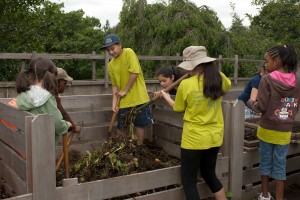 Vegetables and kids: two of my favorite things, growing together in the Ruth Rea Howell Family Garden! Each year we open the gates of our one-and-a-half-acre garden to thousands of children and invite them to help us in our annual effort to grow thousands of plants.
Vegetables and kids: two of my favorite things, growing together in the Ruth Rea Howell Family Garden! Each year we open the gates of our one-and-a-half-acre garden to thousands of children and invite them to help us in our annual effort to grow thousands of plants.
Sitting here now, among the tangles of tomato vines heavy with fruit and rows of sunflowers standing tall, it takes a leap of faith to believe this site was nearly bare when we began. Only a short time ago, I’m certain I was sitting in this same spot bundled in countless layers of thermal fabric with my eyes closed imagining the fragrances that envelope me now, straining to hear the drones of the pollinators patrolling the plots, and wondering at what point in the summer the garlic leaves would collapse under the weight of themselves.
A little over one hundred days later, my imaginations have been realized. The freshly harvested basil leaves stain fingers with their pungent perfume, the bees are busy buzzing in and out of the squash blossoms, and the garlic has already been harvested, braided, and hung in the garage to cure.
Read More
Posted in Learning Experiences, People on July 21 2009, by Plant Talk
 |
Ashley Burke is a second-year student in the School of Professional Horticulture. She is doing her required six-month internship at the High Line in Manhattan, a recently completed elevated public park built on a former rail bed. The School’s internship program is designed to allow students to synthesize and apply what they’ve learned, expand their skills by providing further training in a professional horticulture venue, and expose them to the multiple facets of the field. Ashley sent us this report. |
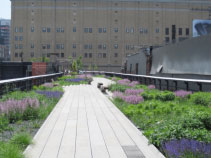 Interning at the High Line, a park on the Lower Westside of Manhattan that opened on June 9, has given me an unparalleled opportunity to observe and learn about how a city park is created.
Interning at the High Line, a park on the Lower Westside of Manhattan that opened on June 9, has given me an unparalleled opportunity to observe and learn about how a city park is created.
I began working at the park in mid-April and as such, have been exposed to various elements of the process. Some of my responsibilities have included compiling a master plant list; verifying what has been planted; creating plant identification cards to be used by the public, with plant names, cultural information, native range, and where it is located in the park; and even selecting horticulture tools. Of course, I also had hands-on plant work: The week before opening, we raced against time to weed, water, and prune to get the park ready for visitors.
I also worked extensively with the plans that were drawn up by the landscape architects, field operations, and the landscape designer, Piet Oudolf (who co-designed the current Seasonal Walk at The New York Botanical Garden), and this has allowed me to familiarize myself with the plants being used. Part of this has been to check that each plant species is properly identified, the name is spelled correctly, and that the plants are located where they are indicated on the plan. Through my experiences, I am learning that one cannot design properly without being able to identify the materials one works with.
Read More
Posted in Learning Experiences on July 9 2009, by Plant Talk
Take Classes in Amagansett, Learn Veggie Gardening, and More!
 |
Duncan Himmelman, Ph.D., is Program Manager for Continuing Education. |
I decided to take advanced physics in the months between my junior and senior years in high school, sensing it would give me a slight edge in the college application process and that it would free up my senior year schedule to pursue extracurricular activities. My friends were aghast: “Nerd” had not yet been coined, but I was certainly viewed as the precursor. Yes, it was difficult, both the advanced physics and loss of fun times with friends and family, but it was taught in such an engaging manner that it galvanized my decision to pursue science in college. Summer school was the key to my future! Who knew?
Summer is the ideal time to take on an academic or leisure time educational pursuit. Continuing Education offers a diversity of programming this summer both here at the Garden and in such far flung places as Amagansett on Long Island. Located in the middle of summer-cottage country, the nearby beaches of Amagansett provide spectacular vistas from which to learn the fundamentals of drawing or watercolor painting. If art is not for you, then learn about garden design or growing roses using a totally organic approach. No matter what, combining the leisurely pace of summer life with a fun course or two can be just what the doctor ordered.
If you are staying closer to home, near the Garden, why not enroll in the one-day Vegetable Gardening for Beginners program on Saturday, July 18. In keeping with The Edible Garden celebration and with the current “grow your own garden” craze sweeping the nation, come get the fundamentals needed to grow a bunch of veggies, from soil preparation and seeding to garden maintenance using strictly organic methods. Summer school was never so much fun.
For those who are more serious-minded about summer school courses, consider signing up for one of the Summer Intensives offered in Botanical Art and Illustration or Floral Design. Located here at the Garden, you will be amazed at the many locations where you can gain inspiration for the Illustration courses and actually sit outdoors to draw. Floral Design, an intensive five-week program, brings you from basic floral techniques through the creative process of designing wedding and “grand scale” arrangements. Perhaps, like my physics summer school course, you’ll find it demanding, but it may also be the touchstone you’ve been waiting for!
Posted in Learning Experiences on June 16 2009, by Plant Talk
 |
Peter Couchman is a second-year student in the School of Professional Horticulture. He is doing his required six-month internship at the five-acre Sands Light estate, home to the Sands Point Lighthouse in Port Washington on the north shore of Long Island. The School’s internship program is designed to allow students to synthesize and apply what they’ve learned, expand their skills by providing further training in a professional horticulture venue, and expose them to the multiple facets of the field. Peter sent us this report.
|
One condition of my accepting this internship was to introduce a composting program: Prior to my arrival, there was no composting on the estate. All garden waste was placed in the municipal garbage.
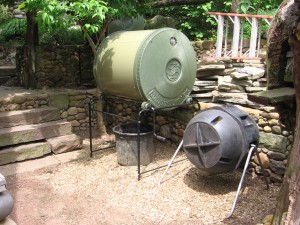 Since my time here, I’m happy to say, I have researched, installed, and implemented a composting facility. With limited space for a compost area, it was important that the facility not be unsightly as it would be close to the house. For that reason, I chose to use compost tumblers, which keep the compost out of sight and are easy to turn and oxygenate. They also keep out wild animals such as the ever-present raccoons. To facilitate the composting process, I established a new wood-chipping area to create a good carbon source of sawdust and woodchips. The main nitrogen source comes from the collected clippings from each week’s lawn mowing. Recently, I began collecting kitchen waste such as eggshells and vegetable and fruit scraps for composting as well. Through composting, we have decreased the amount of waste we place in the municipal garbage by up to 30 percent.
Since my time here, I’m happy to say, I have researched, installed, and implemented a composting facility. With limited space for a compost area, it was important that the facility not be unsightly as it would be close to the house. For that reason, I chose to use compost tumblers, which keep the compost out of sight and are easy to turn and oxygenate. They also keep out wild animals such as the ever-present raccoons. To facilitate the composting process, I established a new wood-chipping area to create a good carbon source of sawdust and woodchips. The main nitrogen source comes from the collected clippings from each week’s lawn mowing. Recently, I began collecting kitchen waste such as eggshells and vegetable and fruit scraps for composting as well. Through composting, we have decreased the amount of waste we place in the municipal garbage by up to 30 percent.
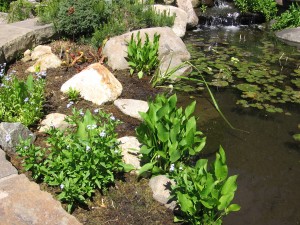 In addition, I designed and installed a new bog garden within an existing pond and waterfall feature. I was able to incorporate Sarracenia leucophylla ‘Tarnok’, Sarracenia purpurea, Iris fulva, Mimulus sp., Pinguicula primuliflora, and other Pinguicula species that the owner already had. We will be adding additional carnivorous and bog plants in the next couple of weeks.
In addition, I designed and installed a new bog garden within an existing pond and waterfall feature. I was able to incorporate Sarracenia leucophylla ‘Tarnok’, Sarracenia purpurea, Iris fulva, Mimulus sp., Pinguicula primuliflora, and other Pinguicula species that the owner already had. We will be adding additional carnivorous and bog plants in the next couple of weeks.
Read More
Posted in Learning Experiences on June 9 2009, by Plant Talk
Monet’s Garden Exposes Subtleties of Color and Light
 |
Christopher Bale is a second-year student in the School of Professional Horticulture. He is doing his required six-month internship at the famous garden at Fondation Claude Monet in Giverny, France, and sent us this report. The School’s internship program is designed to allow students to synthesize and apply what they’ve learned, expand their skills by providing further training in a professional horticulture venue, and expose them to the multiple facets of the field.
|
At the Fondation Claude Monet garden in Giverny, France, I am learning a number of new skills that will serve me in my horticulture career. It is spring, and I am learning about different approaches to spring plantings as well as preparation for summer plantings.
The amazing things about the Monet garden are the subtleties and approaches to the use of color and light. These ideas are reflected in the various areas of the garden and are the design approaches that are the most important aspect of my learning experience.
Daily I am involved in all aspects of horticultural maintenance: pruning, planting, deadheading, and plant production. The new skills I have learned pertain to the day-to-day approaches to management and planning for a garden of this size and stature. I have learned many new plants along with many French common names. Most important has been the strengthening of my knowledge of the distinctions between the Narcissus divisions of the family Amaryllidaceae and the Tulipa types of the Liliaceae.
Posted in Learning Experiences, People on June 3 2009, by Plant Talk
Earns Certificate to Be Awarded at Weekend Ceremony
 |
Stephan Chenault is Director of Science Development. |
This Sunday I will receive my Continuing Education Certificate in Botany. I enrolled in the program soon after joining the Garden’s staff, in August 1998. My decision to study botany was based on a love of nature that dates from my childhood. I still remember my mother taking me on a walk in the woods around Lake George at the age of three and how much I appreciated and was fascinated by acorns, oak leaves, chipmunks, and mushrooms. My goal in pursuing the Botany Certificate was to gain more knowledge of plant life and the natural world so that I would have a key to turn other people on to the natural world.
My past experiences in nature education have been as a counselor and teacher at a camp in New Hampshire. Helping children encounter and enjoy the environment through hikes, nature walks, aquarium- and terrarium-building, gardening, and art has been one of my most rewarding vocations. Later, as a volunteer activist in the Sierra Club, the country’s largest environmental organization, I would participate and help lead hikes with my activist collaborators. Many of these volunteer partners switched careers and became full-time professional environmental leaders, and I, myself, switched careers to take on a position in science fundraising for The New York Botanical Garden.
The knowledge I have gained from being a student in the Continuing Education program has been very helpful to me in understanding the Garden’s scientific programs and describing them to potential donors in the philanthropic community.
Read More
Posted in Learning Experiences on May 28 2009, by Plant Talk
Education Courses Tailor-Made for Groups
 |
Jeff Downing is Vice President for Education.
|
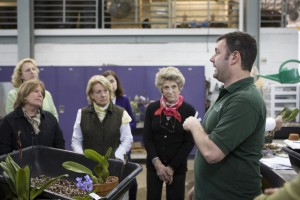 The first time I spoke with Ellen Conrad it was a long phone call. Not in a bad way—there was just a lot to say.
The first time I spoke with Ellen Conrad it was a long phone call. Not in a bad way—there was just a lot to say.
Ellen is the President of the Bedford Garden Club in Westchester County. She called looking for ways to provide high-quality educational content for her club members. With over 500 different courses offered for adults, I assured her that The New York Botanical Garden was certainly a good place to start. I explained that our 300-plus instructors included many of the Garden’s own staff—the world-class horticulturists who bring to life the stunning exhibitions and who care for the collections—in addition to a wide range of professional nurserymen and women, landscape designers, arborists, gardening authors, and others. All have both the knowledge of plant care and the ability to convey these skills in a classroom/workshop environment.
“But that’s just background!” I said. I was getting warmed up.
The Garden had never before customized a curriculum for a Garden Club (at least not in the 10 years I’ve been here), but for some time I had been contemplating the feasibility of such an arrangement. With the array of educational content, instructors, facilities, and resources available, the Garden could ostensibly design a customized curriculum to meet a group’s specific needs, schedule the classes around the group’s availability, and deliver a one-of-a-kind educational experience. All the Bedford Garden Club would need to do is get at least 15 of its members to enroll in the class—“to make it worth the investment of time to develop and schedule a specialized program like this,” I explained. “If you give me 15 students, I can teach you whatever you want. I mean, I could teach you Latin…OK, Botanical Latin, but you get the idea.”
“Wow!” Ellen exclaimed. Now she was as excited as I was. From there the conversation exploded into a dizzying back-and-forth of scheduling concepts, programming ideas, and possible follow-up opportunities down the road if the first course went well.
That was almost a year ago. Since then, the Garden has worked closely with the Bedford Garden Club to devise a tailored curriculum around essential horticulture principles within a schedule that accommodated their needs. Todd Forrest, the Garden’s Vice President for Horticulture and Living Collections, arranged a number of unique Curator-led workshops and special behind-the-scenes tours of Garden exhibitions, including The Orchid Show. When the eight-session course was offered last fall and winter, more than 20 club members participated and were enthusiastic about the results.
I saw Ellen Conrad a few weeks ago. I asked her whether the participants had any further thoughts now that they’ve had time to digest and reflect on the experience. “Sure,” she replied. “What’s next?”
To learn more about tailoring a curriculum for your garden club or interested group, contact Duncan Himmelman at 718.817.8741 or dhimmelman@nybg.org.
Posted in Learning Experiences on May 22 2009, by Plant Talk
Explore, Plant, Scavenge, and Create a Field Journal
 |
Andrew Haight is Manager of the Everett Children’s Adventure Garden. |
Many bright ideas were brought to the table when the Children’s Adventure Garden staff first discussed programming for the spring bulb show, The Glory of Dutch Bulbs. Several exciting suggestions emerged from this creative conversation, which gave life to Bulbs Unearthed.
The Everett Children’s Adventure Garden always tries to find new ways for young children and their families to explore nature and plants through their five senses. As a result, the Bulbs Unearthed program provides the youngest learners with a tactile, interactive experience.
Facilitated by members of the Intern Explainer program for teenagers, visitors to the Adventure Garden learn how bulbs are neatly packaged containers of plant parts. When given the right conditions, they will grow into next year’s plants and will flower. After taking a close look at these parts inside the bulb, children can plant their own bulb in a biodegradable pot to take home. Children can also make a field notebook and go on a scavenger hunt around the Adventure Garden to search for signs of bulbs. Then they can complete the activities by making a paper iris flower.
Beyond bulbs, the Adventure Garden is home to many exciting spring awakenings. Sit outside on the benches and watch the robins nesting in the eaves of the Discovery Center or rest beneath the shade of the Pond Pavilion while mallards graze for duckweed or marvel at the caterpillar, ladybug, and frog topiaries. Come and enjoy all of these exciting opportunities with us.
Check out all of Saturday’s programming
Check out all of Sunday’s programming

 Teachers change the world one child at a time, and they need inspiration and new ideas to keep pushing the boundaries of creativity. Beginning my position as Manager of Teacher Professional Development is an exciting opportunity to listen to teachers and find out what they need to be even more effective in their work.
Teachers change the world one child at a time, and they need inspiration and new ideas to keep pushing the boundaries of creativity. Beginning my position as Manager of Teacher Professional Development is an exciting opportunity to listen to teachers and find out what they need to be even more effective in their work.














